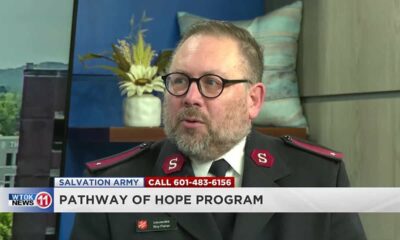Kaiser Health News
Why Covid Patients Who Could Most Benefit From Paxlovid Still Aren’t Getting It
Arthur Allen
Mon, 11 Mar 2024 09:00:00 +0000
Evangelical minister Eddie Hyatt believes in the healing power of prayer but “also the medical approach.” So on a February evening a week before scheduled prostate surgery, he had his sore throat checked out at an emergency room near his home in Grapevine, Texas.
A doctor confirmed that Hyatt had covid-19 and sent him to CVS with a prescription for the antiviral drug Paxlovid, the generally recommended medicine to fight covid. Hyatt handed the pharmacist the script, but then, he said, “She kept avoiding me.”
She finally looked up from her computer and said, “It's $1,600.”
The generally healthy 76-year-old went out to the car to consult his wife about their credit card limits. “I don't think I've ever spent more than $20 on a prescription,” the astonished Hyatt recalled.
That kind of sticker shock has stunned thousands of sick Americans since late December, as Pfizer shifted to commercial sales of Paxlovid. Before then, the federal government covered the cost of the drug.
The price is one reason Paxlovid is not reaching those who need it most. And patients who qualify for free doses, which Pfizer offers under an agreement with the federal government, often don't realize it or know how to get them.
“If you want to create a barrier to people getting a treatment, making it cost a lot is the way to do it,” said William Schaffner, a professor at Vanderbilt University School of Medicine and spokesperson for the National Foundation for Infectious Diseases.
Public and medical awareness of Paxlovid's benefits is low, and putting people through an application process to get the drug when they're sick is a non-starter, Schaffner said. Pfizer says it takes only five minutes online.
It's not an easy drug to use. Doctors are wary about prescribing it because of dangerous interactions with common drugs that treat cholesterol, blood clots, and other conditions. It must be taken within five days of the first symptoms. It leaves a foul taste in the mouth. In one study, 1 in 5 patients reported “rebound” covid symptoms a few days after finishing the medicine — though rebound can also occur without Paxlovid.
A recent JAMA Network study found that sick people 85 and older were less likely than younger Medicare patients to get covid therapies like Paxlovid. The drug might have prevented up to 27,000 deaths in 2022 if it had been allocated based on which patients were at highest risk from covid. Nursing home patients, who account for around 1 in 6 U.S. covid deaths, were about two-thirds as likely as other older adults to get the drug.
Shrunken confidence in government health programs is one reason the drug isn't reaching those who need it. In senior living facilities, “a lack of clear information and misinformation” are “causing residents and their families to be reluctant to take the necessary steps to reduce covid risks,” said David Gifford, chief medical officer for an association representing 14,000 health care providers, many in senior care.
The anti-vaxxers spreading falsehoods about vaccines have targeted Paxlovid as well. Some call themselves anti-paxxers.
“Proactive and health-literate people get the drug. Those who are receiving information more passively have no idea whether it's important or harmful,” said Michael Barnett, a primary care physician at Brigham and Women's Hospital and an associate professor at Harvard, who led the JAMA Network study.
In fact, the drug is still free for those who are uninsured or enrolled in Medicare, Medicaid, or other federal health programs, including those for veterans.
That's what rescued Hyatt, whose Department of Veterans Affairs health plan doesn't normally cover outpatient drugs. While he searched on his phone for a solution, the pharmacist's assistant suddenly appeared from the store. “It won't cost you anything!” she said.
As Hyatt's case suggests, it helps to know to ask for free Paxlovid, although federal officials say they've educated clinicians and pharmacists — like the one who helped Hyatt — about the program.
“There is still a heaven!” Hyatt replied. After he had been on Paxlovid for a few days his symptoms were gone and his surgery was rescheduled.
About That $1,390 List Price
Pfizer sold the U.S. government 23.7 million five-day courses of Paxlovid, produced under an FDA emergency authorization, in 2021 and 2022, at a price of around $530 each.
Under the new agreement, Pfizer commits to provide the drug for the beneficiaries of the government insurance programs. Meanwhile, Pfizer bills insurers for some portion of the $1,390 list price. Some patients say pharmacies have quoted them prices of $1,600 or more.
How exactly Pfizer arrived at that price isn't clear. Pfizer won't say. A Harvard study last year estimated the cost of producing generic Paxlovid at about $15 per treatment course, including manufacturing expenses, a 10% profit markup, and 27% in taxes.
Pfizer reported $12.5 billion in Paxlovid and covid vaccine sales in 2023, after a $57 billion peak in 2022. The company's 2024 Super Bowl ad, which cost an estimated $14 million to place, focused on Pfizer's cancer drug pipeline, newly reinforced with its $43 billion purchase of biotech company Seagen. Unlike some other recent oft-aired Pfizer ads (“If it's covid, Paxlovid”), it didn't mention covid products.
Connecting With Patients
The other problem is getting the drug where it is needed. “We negotiated really hard with Pfizer to make sure that Paxlovid would be available to Americans the way they were accustomed to,” Department of Health and Human Services Secretary Xavier Becerra told reporters in February. “If you have private insurance, it should not cost you much money, certainly not more than $100.”
Yet in nursing homes, getting Paxlovid is particularly cumbersome, said Chad Worz, CEO of the American Society of Consultant Pharmacists, specialists who provide medicines to care homes.
If someone in long-term care tests positive for covid, the nurse tells the physician, who orders the drug from a pharmacist, who may report back that the patient is on several drugs that interact with Paxlovid, Worz said. Figuring out which drugs to stop temporarily requires further consultations while the time for efficacious use of Paxlovid dwindles, he said.
His group tried to get the FDA to approve a shortcut similar to the standing orders that enable pharmacists to deliver anti-influenza medications when there are flu outbreaks in nursing homes, Worz said. “We were close,” he said, but “it just never came to fruition.” “The FDA is unable to comment,” spokesperson Chanapa Tantibanchachai said.
Los Angeles County requires nursing homes to offer any covid-positive patient an antiviral, but the Centers for Medicare & Medicaid Services, which oversees nursing homes nationwide, has not issued similar guidance. “And this is a mistake,” said Karl Steinberg, chief medical officer for two nursing home chains with facilities in San Diego County, which also has no such mandate. A requirement would ensure the patient “isn't going to fall through the cracks,” he said.
While it hasn't ordered doctors to prescribe Paxlovid, CMS on Jan. 4 issued detailed instructions to health insurers urging swift approval of Paxlovid prescriptions, given the five-day window for the drug's efficacy. It also “encourages” plans to make sure pharmacists know about the free Paxlovid arrangement.
Current covid strains appear less virulent than those that circulated earlier in the pandemic, and years of vaccination and covid infection have left fewer people at risk of grave outcomes. But risk remains, particularly among older seniors, who account for most covid deaths, which number more than 13,500 so far this year in the U.S.
Steinberg, who sees patients in 15 residences, said he orders Paxlovid even for covid-positive patients without symptoms. None of the 30 to 40 patients whom he prescribed the drug in the past year needed hospitalization, he said; two stopped taking it because of nausea or the foul taste, a pertinent concern in older people whose appetites already have ebbed.
Steinberg said he knew of two patients who died of covid in his companies' facilities this year. Neither was on Paxlovid. He can't be sure the drug would have made a difference, but he's not taking any chances. The benefits, he said, outweigh the risks.
Reporter Colleen DeGuzman contributed to this report.
——————————
By: Arthur Allen
Title: Why Covid Patients Who Could Most Benefit From Paxlovid Still Aren't Getting It
Sourced From: kffhealthnews.org/news/article/paxlovid-pfizer-covid-antiviral-commercial-sales-access/
Published Date: Mon, 11 Mar 2024 09:00:00 +0000
Did you miss our previous article…
https://www.biloxinewsevents.com/california-attorney-general-boosts-bill-banning-medical-debt-from-credit-reports/
Kaiser Health News
Millions Were Booted From Medicaid. The Insurers That Run It Gained Medicaid Revenue Anyway.
Phil Galewitz, KFF Health News
Fri, 26 Apr 2024 13:55:00 +0000
Private Medicaid health plans lost millions of members in the past year as pandemic protections that prohibited states from dropping anyone from the government program expired.
But despite Medicaid's unwinding, as it's known, at least two of the five largest publicly traded companies selling plans have continued to increase revenue from the program, according to their latest earnings reports.
“It's a very interesting paradox,” said Andy Schneider, a research professor at Georgetown University's McCourt School of Public Policy, of plans' Medicaid revenue increasing despite enrollment drops.
Medicaid, the state-federal health program for low-income and disabled people, is administered by states. But most people enrolled in the program get their health care through insurers contracted by states, including UnitedHealthcare, Centene, and Molina.
The companies persuaded states to pay them more money per Medicaid enrollee under the assumption that younger and healthier people were dropping out — presumably for Obamacare coverage or employer-based health insurance, or because they didn't see the need to get coverage — leaving behind an older and sicker population to cover, their executives have told investors.
Several of the companies reported that states have made midyear and retrospective changes in their payments to plans to account for the worsening health status of members.
In an earnings call with analysts on April 25, Molina Healthcare CEO Joe Zubretsky said 19 states increased their payment rates this year to adjust for sicker Medicaid enrollees. “States have been very responsive,” Zubretsky said. “We couldn't be more pleased with the way our state customers have responded to having rates be commensurate with normal cost trends and trends that have been influenced by the acuity shift.”
Health plans have faced much uncertainty during the Medicaid unwinding, as states began reassessing enrollees' eligibility and dropping those deemed no longer qualified or who lost coverage because of procedural errors. Before the unwinding, plans said they expected the overall risk profile of their members to go up because those remaining in the program would be sicker.
UnitedHealthcare, Centene, and Molina had Medicaid revenue increases ranging from 3% to 18% in 2023, according to KFF. The two other large Medicaid insurers, Elevance and CVS Health, do not break out Medicaid-specific revenue.
The Medicaid enrollment of the five companies collectively declined by about 10% from the end of March 2023 through the end of December 2023, from 44.2 million people to 39.9 million, KFF data shows.
In the first quarter of 2024, UnitedHealth's Medicaid revenue rose to $20.5 billion, up from $18.8 billion in the same quarter of 2023.
Molina on April 24 reported nearly $7.5 billion in Medicaid revenue in the first quarter of 2024, up from $6.3 billion in the same quarter a year earlier.
On April 26, Centene reported that its Medicaid enrollment fell 18.5% to 13.3 million in the first quarter of 2024 compared with the same period a year ago. The company's Medicaid revenue dipped 3% to $22.2 billion.
Unlike UnitedHealthcare, whose Medicaid enrollment fell to 7.7 million in March 2024 from 8.4 million a year prior, Molina's Medicaid enrollment rose in the first quarter of 2024 to 5.1 million from 4.8 million in March 2023. Molina's enrollment jump last year was partly a result of its having bought a Medicaid plan in Wisconsin and gained a new Medicaid contract in Iowa, the company said in its earnings news release.
Molina added 1 million members because states were prohibited from terminating Medicaid coverage during the pandemic. The company has lost 550,000 of those people during the unwinding and expects to lose an additional 50,000 by June.
About 90% of Molina Medicaid members have gone through the redetermination process, Zubretsky said.
The corporate giants also offset the enrollment losses by getting more Medicaid money from states, which they use to pass on higher payments to certain facilities or providers, Schneider said. By holding the money temporarily, the companies can count these “directed payments” as revenue.
Medicaid health plans were big winners during the pandemic after the federal government prohibited states from dropping people from the program, leading to a surge in enrollment to about 93 million Americans.
States made efforts to limit health plans' profits by clawing back some payments above certain thresholds, said Elizabeth Hinton, an associate director at KFF.
But once the prohibition on dropping Medicaid enrollees was lifted last spring, the plans faced uncertainty. It was unclear how many people would lose coverage or when it would happen. Since the unwinding began, more than 20 million people have been dropped from the rolls.
Medicaid enrollees' health care costs were lower during the pandemic, and some states decided to exclude pandemic-era cost data as they considered how to set payment rates for 2024. That provided yet another win for the Medicaid health plans.
Most states are expected to complete their Medicaid unwinding processes this year.
——————————
By: Phil Galewitz, KFF Health News
Title: Millions Were Booted From Medicaid. The Insurers That Run It Gained Medicaid Revenue Anyway.
Sourced From: kffhealthnews.org/news/article/medicaid-unwinding-insurer-revenue/
Published Date: Fri, 26 Apr 2024 13:55:00 +0000
Did you miss our previous article…
https://www.biloxinewsevents.com/california-is-investing-500m-in-therapy-apps-for-youth-advocates-fear-it-wont-pay-off/
Kaiser Health News
California Is Investing $500M in Therapy Apps for Youth. Advocates Fear It Won’t Pay Off.
Molly Castle Work
Fri, 26 Apr 2024 09:00:00 +0000
With little pomp, California launched two apps at the start of the year offering free behavioral health services to youths to help them cope with everything from living with anxiety to body acceptance.
Through their phones, young people and some caregivers can meet BrightLife Kids and Soluna coaches, some who specialize in peer support or substance use disorders, for roughly 30-minute virtual counseling sessions that are best suited to those with more mild needs, typically those without a clinical diagnosis. The apps also feature self-directed activities, such as white noise sessions, guided breathing, and videos of ocean waves to help users relax.
“We believe they're going to have not just great impact, but wide impact across California, especially in places where maybe it's not so easy to find an in-person behavioral health visit or the kind of coaching and supports that parents and young people need,” said Gov. Gavin Newsom's health secretary, Mark Ghaly, during the Jan. 16 announcement.
The apps represent one of the Democratic governor's major forays into health technology and come with four-year contracts valued at $498 million. California is believed to be the first state to offer a mental health app with free coaching to all young residents, according to the Department of Health Care Services, which operates the program.
However, the rollout has been slow. So slow that one of the companies has missed a deadline to make its app available on Android phones. Only about 15,000 of the state's 12.6 million children and young adults have signed up for the apps, and school counselors say they've never heard of them.
Advocates for youth question the wisdom of investing taxpayer dollars in two private companies. Social workers are concerned the companies' coaches won't properly identify youths who need referrals for clinical care. And the spending is drawing lawmaker scrutiny amid a state deficit pegged at as much as $73 billion.
An App for That
Newsom's administration says the apps fill a need for young Californians and their families to access professional telehealth for free, in multiple languages, and outside of standard 9-to-5 hours. It's part of Newsom's sweeping $4.7 billion master plan for kids' mental health, which was introduced in 2022 to increase access to mental health and substance use support services. In addition to launching virtual tools such as the teletherapy apps, the initiative is working to expand workforce capacity, especially in underserved areas.
“The reality is that we are rarely 6 feet away from our devices,” said Sohil Sud, director of Newsom's Children and Youth Behavioral Health Initiative. “The question is how we can leverage technology as a resource for all California youth and families, not in place of, but in addition to, other behavioral health services that are being developed and expanded.”
The virtual platforms come amid rising depression and suicide rates among youth and a shortage of mental health providers. Nearly half of California youths from the ages of 12 to 17 report having recently struggled with mental health issues, with nearly a third experiencing serious psychological distress, according to a 2021 study by the UCLA Center for Health Policy Research. These rates are even higher for multiracial youths and those from low-income families.
But those supporting youth mental health at the local level question whether the apps will move the needle on climbing depression and suicide rates.
“It's fair to applaud the state of California for aggressively seeking new tools,” said Alex Briscoe of California Children's Trust, a statewide initiative that, along with more than 100 local partners, works to improve the social and emotional health of children. “We just don't see it as fundamental. And we don't believe the youth mental health crisis will be solved by technology projects built by a professional class who don't share the lived experience of marginalized communities.”
The apps, BrightLife Kids and Soluna, are operated by two companies: Brightline, a 5-year-old venture capital-backed startup; and Kooth, a London-based publicly traded company that has experience in the U.K. and has also signed on some schools in Kentucky and Pennsylvania and a health plan in Illinois. In the first five months of Kooth's Pennsylvania pilot, 6% of students who had access to the app signed up.
Brightline and Kooth represent a growing number of health tech firms seeking to profit in this space. They beat out dozens of other bidders including international consulting companies and other youth telehealth platforms that had already snapped up contracts in California.
Although the service is intended to be free with no insurance requirement, Brightline's app, BrightLife Kids, is folded into and only accessible through the company's main app, which asks for insurance information and directs users to paid licensed counseling options alongside the free coaching. After KFF Health News questioned why the free coaching was advertised below paid options, Brightline reordered the page so that, even if a child has high-acuity needs, free coaching shows up first.
The apps take an expansive view of behavioral health, making the tools available to all California youth under age 26 as well as caregivers of babies, toddlers, and children 12 and under. When KFF Health News asked to speak with an app user, Brightline connected a reporter with a mother whose 3-year-old daughter was learning to sleep on her own.
‘It's Like Crickets'
Despite being months into the launch and having millions in marketing funds, the companies don't have a definitive rollout timeline. Brightline said it hopes to have deployed teams across the state to present the tools in person by midyear. Kooth said developing a strategy to hit every school would be “the main focus for this calendar year.”
“It's a big state — 58 counties,” Bob McCullough of Kooth said. “It'll take us a while to get to all of them.”
Brightline's contract states that the company was required to launch downloadable apps for iOS and Android phones by January, but so far BrightLife Kids is available only on Apple phones. Brightline said it's aiming to launch the Android version over the summer.
“Nobody's really done anything like this at this magnitude, I think, in the U.S. before,” said Naomi Allen, a co-founder and the CEO of Brightline. “We're very much in the early innings. We're already learning a lot.”
The contracts, obtained by KFF Health News through a records request, show the companies operating the two apps could earn as much as $498 million through the contract term, which ends in June 2027, months after Newsom is set to leave office. And the state is spending hundreds of millions more on Newsom's virtual behavioral health strategy. The state said it aims to make the apps available long-term, depending on usage.
The state said 15,000 people signed up in the first three months. When KFF Health News asked how many of those users actively engaged with the app, it declined to say, noting that data would be released this summer.
KFF Health News reached out to nearly a dozen California mental health professionals and youths. None of them were aware of the apps.
“I'm not hearing anything,” said Loretta Whitson, executive director of the California Association of School Counselors. “It's like crickets.”
Whitson said she doesn't think the apps are on “anyone's” radar in schools, and she doesn't know of any schools that are actively advertising them. Brightline will be presenting its tool to the counselor association in May, but Whitson said the company didn't reach out to plan the meeting; she did.
Concern Over Referrals
Whitson isn't comfortable promoting the apps just yet. Although both companies said they have a clinical team on staff to assist, Whitson said she's concerned that the coaches, who aren't all licensed therapists, won't have the training to detect when users need more help and refer them to clinical care.
This sentiment was echoed by other school-based social workers, who also noted the apps' duplicative nature — in some counties, like Los Angeles, youths can access free virtual counseling sessions through Hazel Health, a for-profit company. Nonprofits, too, have entered this space. For example, Teen Line, a peer-to-peer hotline operated by Southern California-based Didi Hirsch Mental Health Services, is free nationwide.
While the state is also funneling money to the schools as part of Newsom's master plan, students and school-based mental health professionals voiced confusion at the large app investment when, in many school districts, few in-person counseling roles exist, and in some cases are dwindling.
Kelly Merchant, a student at College of the Desert in Palm Desert, noted that it can be hard to access in-person therapy at her school. She believes the community college, which has about 15,000 students, has only one full-time counselor and one part-time bilingual counselor. She and several students interviewed by KFF Health News said they appreciated having engaging content on their phone and the ability to speak to a coach, but all said they'd prefer in-person therapy.
“There are a lot of people who are seeking therapy, and people close to me that I know. But their insurances are taking forever, and they're on the waitlist,” Merchant said. “And, like, you're seeing all these people struggle.”
Fiscal conservatives question whether the money could be spent more effectively, like to bolster county efforts and existing youth behavioral health programs.
Republican state Sen. Roger Niello, vice chair of the Senate Budget and Fiscal Review Committee, noted that California is forecasted to face deficits for the next three years, and taxpayer watchdogs worry the apps might cost even more in the long run.
“What starts as a small financial commitment can become uncontrollable expenses down the road,” said Susan Shelley of the Howard Jarvis Taxpayers Association.
This article was produced by KFF Health News, which publishes California Healthline, an editorially independent service of the California Health Care Foundation.
——————————
By: Molly Castle Work
Title: California Is Investing $500M in Therapy Apps for Youth. Advocates Fear It Won't Pay Off.
Sourced From: kffhealthnews.org/news/article/california-youth-teletherapy-apps-rollout-slow/
Published Date: Fri, 26 Apr 2024 09:00:00 +0000
Kaiser Health News
KFF Health News’ ‘What the Health?’: Abortion — Again — At the Supreme Court
Wed, 24 Apr 2024 20:30:00 +0000
The Host
Julie Rovner
KFF Health News
Julie Rovner is chief Washington correspondent and host of KFF Health News' weekly health policy news podcast, “What the Health?” A noted expert on health policy issues, Julie is the author of the critically praised reference book “Health Care Politics and Policy A to Z,” now in its third edition.
Some justices suggested the Supreme Court had said its piece on abortion law when it overturned Roe v. Wade in 2022. This term, however, the court has agreed to review another abortion case. At issue is whether a federal law requiring emergency care in hospitals overrides Idaho's near-total abortion ban. A decision is expected by summer.
Meanwhile, the Centers for Medicare & Medicaid finalized the first-ever minimum staffing requirements for nursing homes participating in the programs. But the industry argues that there are not enough workers to hire to meet the standards.
This week's panelists are Julie Rovner of KFF Health News, Joanne Kenen of the Johns Hopkins University's nursing and public health schools and Politico Magazine, Tami Luhby of CNN, and Alice Miranda Ollstein of Politico.
Panelists
Joanne Kenen
Johns Hopkins University and Politico
Tami Luhby
CNN
Alice Miranda Ollstein
Politico
Among the takeaways from this week's episode:
- This week's Supreme Court hearing on emergency abortion care in Idaho was the first challenge to a state's abortion ban since the overturn of the constitutional right to an abortion. Unlike previous abortion cases, this one focused on the everyday impacts of bans on abortion care — cases in which pregnant patients experienced medical emergencies.
- Establishment medical groups and doctors themselves are getting more vocal and active as states set laws on abortion access. In a departure from earlier political moments, some major medical groups are campaigning on state ballot measures.
- Medicaid officials this week finalized new rules intended to more closely regulate managed-care plans that enroll Medicaid patients. The rules are intended to ensure, among other things, that patients have prompt access to needed primary care doctors and specialists.
- Also this week, the Federal Trade Commission voted to ban most “noncompete” clauses in employment contracts. Such language has become common in health care and prevents not just doctors but other health workers from changing jobs — often forcing those workers to move or commute to leave a position. Business interests are already suing to block the new rules, claiming they would be too expensive and risk the loss of proprietary information to competitors.
- The fallout from the cyberattack of Change Healthcare continues, as yet another group is demanding ransom from UnitedHealth Group, Change's owner. UnitedHealth said in a statement this week that the records of “a substantial portion of America” may be involved in the breach.
Plus for “extra credit” the panelists suggest health policy stories they read this week that they think you should read, too:
Julie Rovner: NBC News' “Women Are Less Likely To Die When Treated by Female Doctors, Study Suggests,” by Liz Szabo.
Alice Miranda Ollstein: States Newsroom's “Loss of Federal Protection in Idaho Spurs Pregnant Patients To Plan for Emergency Air Transport,” by Kelcie Moseley-Morris.
Tami Luhby: The Associated Press' “Mississippi Lawmakers Haggle Over Possible Medicaid Expansion as Their Legislative Session Nears End,” by Emily Wagster Pettus.
Joanne Kenen: States Newsroom's “Missouri Prison Agency To Pay $60K for Sunshine Law Violations Over Inmate Death Records,” by Rudi Keller.
Also mentioned on this week's podcast:
- American Economic Review's “Is There Too Little Antitrust Enforcement in the U.S. Hospital Sector?” by Zarek Brot-Goldberg, Zack Cooper, Stuart Craig, and Lev Klarnet.
- KFF Health News' “Medical Providers Still Grappling With UnitedHealth Cyberattack: ‘More Devastating Than Covid,” by Samantha Liss.
Credits
Francis Ying
Audio producer
Emmarie Huetteman
Editor
To hear all our podcasts, click here.
And subscribe to KFF Health News' “What the Health?” on Spotify, Apple Podcasts, Pocket Casts, or wherever you listen to podcasts.
——————————
Title: KFF Health News' ‘What the Health?': Abortion — Again — At the Supreme Court
Sourced From: kffhealthnews.org/news/podcast/what-the-health-344-abortion-supreme-court-april-25-2024/
Published Date: Wed, 24 Apr 2024 20:30:00 +0000
Did you miss our previous article…
https://www.biloxinewsevents.com/mandatory-reporting-laws-meant-to-protect-children-get-another-look/
-
228Sports7 days ago
From Heartbreak to Hoop Dreams: Pascagoula Panthers Springboard from Semifinal Setback to College Courts
-
Local News2 days ago
Sister of Mississippi man who died after police pulled him from car rejects lawsuit settlement
-
Mississippi News6 days ago
2 dead, 6 hurt in shooting at Memphis, Tennessee block party: police
-
Mississippi News6 days ago
Forest landowners can apply for federal emergency loans
-
Mississippi Today2 days ago
At Lake High School in Scott County, the Un-Team will never be forgotten
-
Mississippi News5 days ago
Cicadas expected to takeover north Mississippi counties soon
-
Mississippi News4 days ago
Viewers make allegations against Hatley teacher, school district releases statement – Home – WCBI TV
-
Mississippi News6 days ago
Nationwide health alert issued for ground beef over potential E. coli risk





































